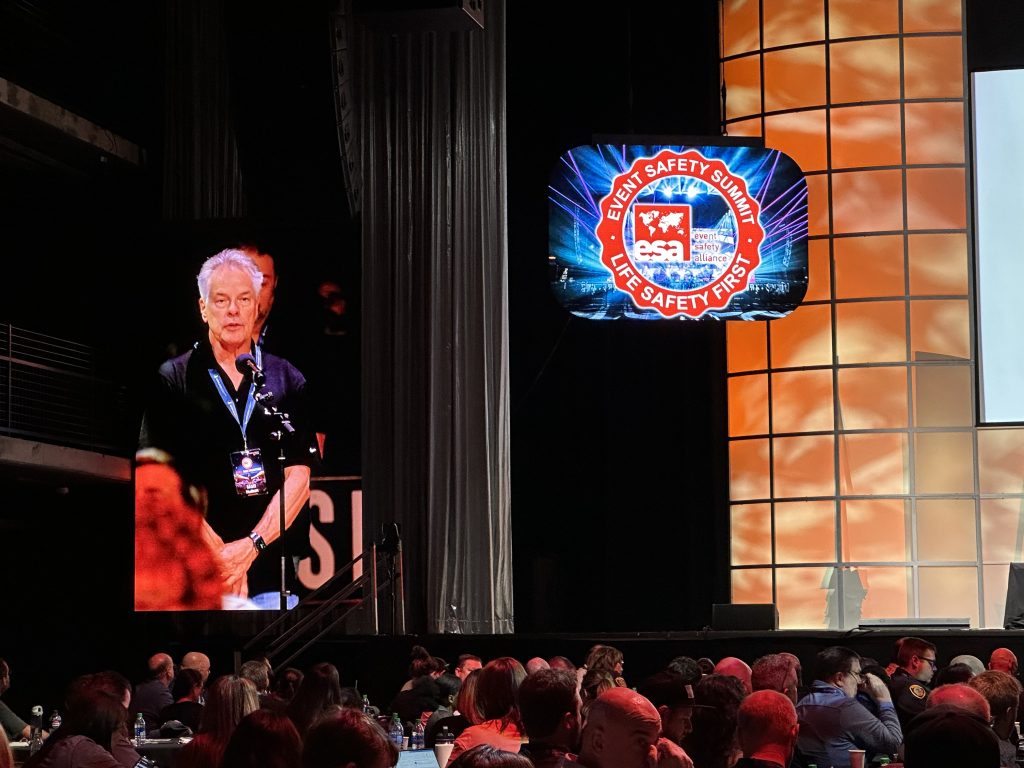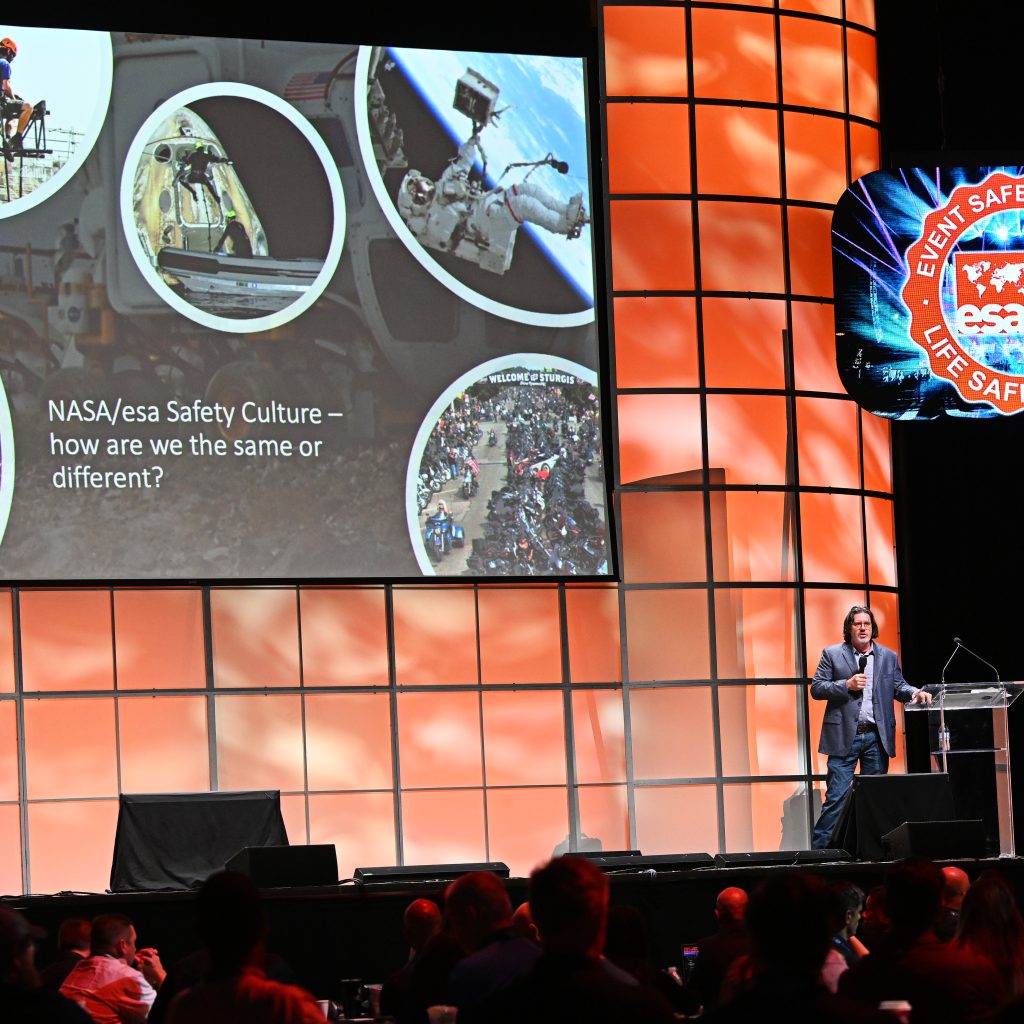

RECENTLY, SIOBHAN COLLEEN, Asst. Director of Safety and Training of Rhino Staging and Event Services attended the 2023 Event Safety Summit in the City of Houston, Texas. Also in attendance from Rhino Staging was MATT HUDSON, Director of Safety, Training, and Rigging; ISRAEL JIMENEZ, Texas Safety and Training Manager; and J BLAIN, Colorado Safety and Training Manager. JAMES MCCARTHY, Director of Communications, interviews Siobhan to glimpse through her perspective of the Event Safety Summit and her big takeaways.
What is the Event Safety Summit?

James McCarthy: Can you tell us what the Event Safety Summit is?
Siobhan Colleen: The Event Safety Summit is a gathering of thought leaders, subject matter experts, and incredible people who represent the live events industry.
JM: Can you elaborate on the people who attend the Event Safety Summit?
SC: It’s truly amazing. You meet crowd safety scientists, clinical psychologists, meteorologists and climate experts, production managers, live event producers, fall protection experts, venue managers, and technical production crew. That barely scratches the surface of the kind of crowd the Event Safety Summit gathers!
JM: That’s quite the audience! What was your role in all of this?
SC: I volunteer for the host organization, the Event Safety Alliance, and co-present Evaluating Your Fall Protection System with Matt Hudson.
What is the Event Safety Alliance (ESA)?

JM: Tell us about the Event Safety Alliance (ESA).
SC: The ESA is a non-profit that dedicates itself to promoting life safety first. It was born through the tragedy of the 2011 Indiana State Fair when severe weather caused the collapse of the concert roof structure for the main stage, resulting in death and severe injuries. In response, Jim Digby, Linkin Park tour manager, founded the Event Safety Alliance in 2012. You can read more about the story in an article written by Steve Adelman.
JM: And the ESA mission?
SC: To help live-event industry professionals be EDUCATED, SAFE, and AWARE of reasonably foreseeable risks through EDUCATION, SKILLS training, and ADVOCACY.
JM: How did you become an ESA advocate?
SC: Safety is at the core of everything I do. My background in rigging helped cultivate those values for me. I first discovered the ESA while researching COVID-19 workplace guidance. While the CDC and WHO guided the world, the ESA published the Event Safety Alliance Reopening Guide for the live events industry. That opened the door to discovering many other incredible resources such as The Event Safety Guide. After attending my first summit, I decided to continue donating my time to the Advancement and Membership committees.
Event Safety Summit After Hours
JM: What were your biggest highlights from the Event Safety Summit?
SC: Without a doubt, this summit made me realize that what we do matters. All of our efforts toward promoting a positive safety culture make a true difference in the real lives of people in this industry. Two moments confirmed this for me. The first was during dinner with some of the hard-working professionals from G2 Structures. They shared impactful safety stories with us, including their fond memories of SPRAT and rigging training with our Matt Hudson. You can see in their body language how much passion they have for their craft and their people. You can see their motivation to improve the culture. They have an extraordinary sense of compassion for their team. It makes me happy to know that there are incredible crew members like that out there working alongside our Rhino stagehands. The second moment was during a debrief of the summit with our Colorado safety and training manager, J Blain. Throughout this concert season, J noticed key cultural shifts including an increase in respect toward fall prevention efforts and successful heat illness prevention strategies in action. As a safety director, hearing how our safety and training program positively impacts not just our stagehands, but the crews working with us, gives me the deepest satisfaction. It’s why I do what I do.
JM: It seems as though your top moments happened after hours.
SC: You know, you’re absolutely right. Between the sessions and networking events, there’s this expanded capacity for reflection and introspection that happens. The Event Safety Summit has a knack for making you consider things beyond your typical train of thought. I believe that in part has to do with the breadth of topics covered by experts with diverse professional backgrounds.
Mental Health in Event Safety

JM: That’s quite the psychological experience. Is there any consideration for mental health as it relates to event safety?
SC: Yes, in fact, another highlight of mine is the Understanding Trauma and Healing in the Aftermath of Crisis session by Dr. Chayim Newman, clinical psychologist and co-founder of Amber Health, and Scott Scovill, owner of Moo TV and Center Staging. There was real raw emotion on and offstage. Onstage, you could see Scott relive the emotions from some traumatic experiences that deeply affect him. He is incredibly relatable because some of us have experiences from those very same traumatic events. Dr. Newman reinforces the importance of human connection as a means to help each other in the aftermath of a traumatic event. It comes down to helping people feel like the world is a safe place and interacting with them in a comfortable and meaningful way.
JM: That certainly enforces the importance of mental health first aid training.
SC: It does, I’m grateful to the Behind the Scenes Foundation for providing mental health first aid training sessions to our Rhino Staging team.
Normalization of Deviance

JM: Can you share one final highlight from your experience at the Event Safety Summit?
SC: Blow pops and rocket science. NASA Deputy Director of Safety and Mission Assurance, Nathan Vassberg was the keynote speaker. You could say he launched the summit. Space is a harsh and unforgiving environment for the crews that travel there. Nathan discussed four NASA accidents. Three of the stories end with crew death, the Space Shuttle Challenger explosion and the O-ring being among those stories. “Normalization of deviance” was a common theme among these stories. It’s when you practice what should not be acceptable to the point where that bad practice becomes the norm. “Launch fever” was a cause identified in one of the incident investigations. To me, that’s similar to “the show must go on.” Each story has its lessons learned in which Nathan describes the corrective action and engineering improvements made to prevent future incidents. One of the stories was a near miss that could have resulted in the death of an astronaut. That story particularly resonates with me.
NASA Near Miss
JM: Why is that?
SC: While that astronaut was doing a routine spacewalk, water started seeping into his helmet. The team on Earth didn’t think much of it. But the issue persisted, becoming increasingly deadly. The team decided to terminate the spacewalk and by the time the astronaut made it back into the airlock, there was so much water that he said he wasn’t sure where he’d get his next breath. He could have drowned in space. That spacesuit had not had a failure like that in nearly 40 years. Nearly 40 years. That makes me think about the times that I’ve seen severely kinked rigging steel. Just because it’s been used for so many years, doesn’t mean it won’t one day fail. Many examples like that illustrate the importance of not settling into the dangerous mindset of, “we’ve always used this gear,” or, “we’ve always done it this way.”
Blow Pops and Rocket Science
JM: Where do Blow Pops come into the picture?
SC: Oh yeah! I asked Nathan how he cultivates a positive safety culture at NASA. He creates meaningful connections with people by asking them about their interests and their families. He also happens to carry a bag of Blow Pops around and asks people if they want a sucker for coming into work. It’s brilliant.
JM: I’m surprised you didn’t mention your Backstage at the Event Safety Summit interviews as your final highlight.
SC: [chuckles] Thank you for mentioning it on my behalf.
Happy New Year 2024

JM: Siobhan, thank you for sharing your unique perspective of the Event Safety Summit.
SC: Anytime. I’m telling you, we barely scratched the surface.
JM: I’m sure! Where will you represent Rhino Staging after the New Year?
SC: In January, Matt and I are tailoring our fall protection session for touring professionals at the Live Production Summit (LPS) 2024 in Palm Springs, CA. In March, we are hosting a fall protection harness lab for university students and theater professionals at USITT 2024 in Seattle, WA. A brand new rescue session is in the works for 2024-2025 industry conferences, trade shows, and summits.